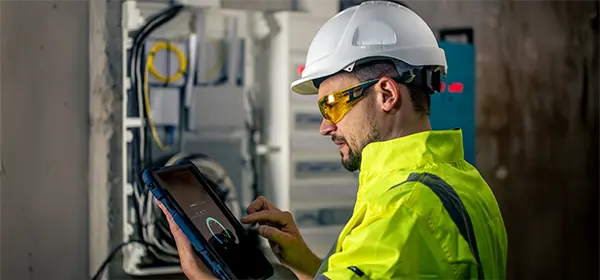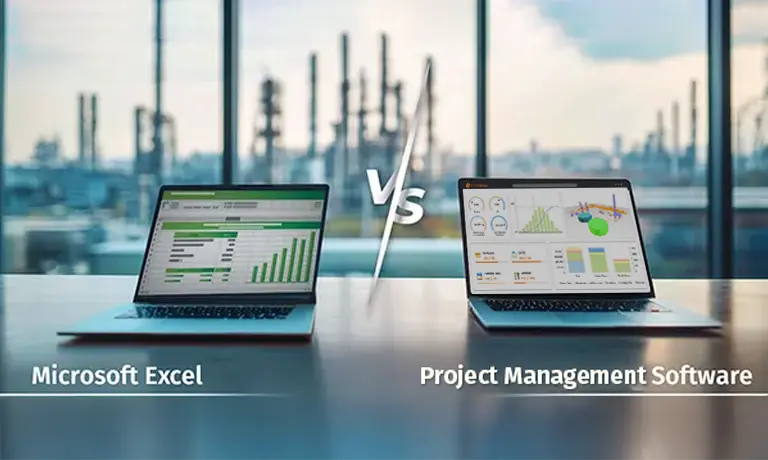
Capital project execution has always presented significant challenges. Managing massive budgets, strict deadlines, and multiple interconnected components requires proper coordination and control. However, what has changed is our ability to leverage mobile technology to actively support project management.
Mobile devices aren’t just convenient, they are essential for maintaining project momentum and control. When field teams can connect instantly with office operations, provide real-time updates, and address issues immediately, project efficiency improves dramatically. The trick is integrating these mobile capabilities with your existing capital project management software.
Common Challenges in Capital Project Execution

Capital projects are complex by nature: large in scale, high in cost, and tightly governed by schedules and compliance standards. While planning and budgeting often receive extensive attention, the execution phase is where timelines slip, costs escalate, and risks materialize. Common challenges include:
Lack of Real-Time Field Visibility
One of the biggest execution challenges in capital projects is the slow and fragmented flow of information between field teams and office-based decision-makers. Field updates are often dependent on manual reporting or disconnected systems. For example, a supervisor might have to inspect progress on-site and then return to a workstation to input the data, leaving a gap during which no one has visibility into the task’s real-time status.
This delay in information also undermines the ability of project controls teams to maintain accurate forecasts and manage resources effectively, as having incomplete or outdated data can lead to scheduling surprises and budget overruns. The risk is even greater in safety-critical activities like isolations, where precise timing is essential and any uncertainty can compromise safety.
Cumbersome QA/QC and Inspection Workflows
Paper-based quality checks slow down inspections and increase the risk of errors or missing documentation. These workflows often require inspectors to take notes in the field and later transfer data to a system, which can lead to double work and delay updates.
Change Management Bottlenecks
Scope changes, site conditions, or discovered issues often face delays in being reported and resolved. This increases the risk of rework and affects cost and schedule forecasts.
Fragmented Coordination Across Stakeholders
With multiple contractors, suppliers, and internal teams involved, ensuring everyone is aligned on priorities and status is an ongoing challenge. In emergencies or safety incidents, delays in communication can compromise response efforts and increase risk. Knowing where people are, what they’re working on, and how to alert them instantly is vital in these situations.
These pain points don’t come from poor planning but from a lack of real-time execution control. The solution? The use of mobile devices.
How Mobile Devices Enhance Capital Project Execution

Mobile devices directly address these execution challenges by enabling field teams to communicate and report in real time. Here’s how they make a difference:
Real-Time Field Visibility and Access To Information
With mobile apps, field teams can access the latest drawings, documents, and schedules while on site. Therefore, there is no need to rely on outdated printouts or second-hand updates anymore. Equally important, they can log progress, flag deviations, and log issues using photos, geolocation, and digital signatures. This makes project data more accurate and traceable.
Faster Field Reporting and Coordinated Decision-Making
Construction delays, equipment issues, or scope changes often demand immediate attention across multiple disciplines. With features like push notifications, instant messaging, and structured form submissions, mobile tools ensure the right people are notified on time. When all stakeholders are working from the same real-time data, it reduces the risk of duplicated work, miscommunication, or schedule slippage.
In addition, mobile devices support dynamic, multi-way communication through group messaging apps (e.g., WhatsApp). Unlike traditional radios, which are limited to a fixed number of channels, these platforms allow teams to create task-specific groups that enhance responsiveness, especially during high-risk or fast-paced activities.
Streamlined Change and Issue Resolution From The Field
Scope growth and unforeseen site conditions are common in capital project execution. Mobile devices make it easy to capture and escalate these changes from the field. Teams can initiate change requests, attach photos, and track resolution status all from the same interface. This reduces cycle time for approvals and helps ensure that impacts are properly recorded for cost and schedule forecasting.
Digital QA/QC and Field Inspections
Instead of relying on printed forms and manual signoffs, mobile devices allow QA/QC teams to perform inspections, complete checklists, and submit quality documentation on the spot. This helps ensure compliance with project specifications and reduces the risk of missing critical handover requirements at the end of capital project execution.
Improved Safety Response and Compliance Oversight
Mobile tools also play a role in maintaining safety and regulatory compliance. Safety observations and incidents can be reported immediately from the field, enhancing visibility and enabling a faster response. During incidents, mobile communications can instantly notify everyone where it occurred and what action is required, supporting faster evacuations or lockdowns.
Considerations When Implementing Mobile Solutions in CAPEX Projects
While the benefits are clear, implementing mobile technology in capital project environments, especially industrial ones, comes with specific challenges:
1. Site Regulations and Device Certification
Many plants restrict mobile use or require certified explosion-proof (e.g., ATEX) devices. These rugged, zone-rated devices (e.g., Zone 1/Zone 2 phones) are essential in hazardous environments but are heavier and more expensive than standard devices.
2. Prioritizing Usability and Comfort in Device Selection
Carrying a bulky ATEX phone or combined mobile-radio device throughout the day can be a burden, especially in tight spaces. Thus, the industry trend is toward multifunctional devices (e.g., mobile phones with integrated walkie-talkie functions) to reduce the amount of gear needed without compromising functionality.
3. Planning for Limited Connectivity On-Site
Factory sites are often challenging environments for wireless coverage. Therefore, mobile tools should include an offline functionality where the data can be stored locally on the device and sync once back in range. This will ensure their usability throughout the site.
4. Balancing Mobile Device Cost with ROI
Mobile devices, especially those certified for hazardous environments, can be a significant investment. Deciding whether the device is a project-specific tool or a long-term asset is an important strategic consideration. For instance, a mobile device purchased for a turnaround could be later given to the operations department to spread the investment over a longer period.
5. IT Security and Device Management
Large organizations must control how mobile devices are used to protect their networks and systems. This is typically done through multi-mobile device management tools, which allow IT departments to remotely manage apps, permissions, and access settings. However, the challenge lies in balancing security with usability, as devices must remain simple and flexible for field use while safeguarding IT infrastructures.
6. Change Management and Workforce Adoption
Another important consideration is the willingness of the workforce to change. Adopting new technology is often more about people than devices. Therefore, consider the workforce’s willingness to change. Ensuring sufficient training, support, and involvement from end users can make the transition smoother and increase long-term adoption.
By bridging the gap between the field and the office through real-time data, multi-way communication, and digital workflows, mobile devices are reshaping the execution of capital projects. When these capabilities are integrated with a capital project management solution like Cleopatra Enterprise, teams can gain the agility, visibility, and control needed to manage cost, schedule, and scope more effectively.
Shutdowns, Turnarounds and Outages (STO) events often involve project scope, which introduces many challenges. Especially meeting event schedules.…
As a cost engineer looking for a cost estimating software tool to create and manage estimates, one of your most…
Related resources

What Is A Capital Project?
Explore capital projects, examples, key challenges, and how capital project management software drives success in complex projects.
Read blog article
Project Management Software VS Excel: A Complete Comparison
Project Management Software vs Excel: Which is best for your projects? Compare scalability, automation, and more to make the right choice.
Read blog article